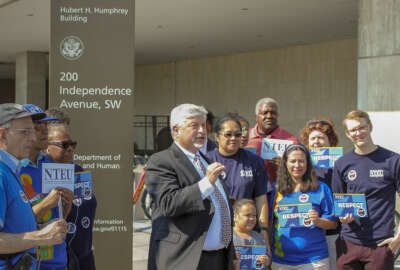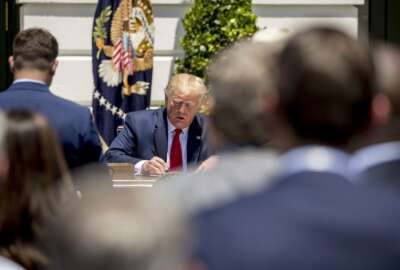
Appeals court won’t allow agencies to immediately enforce Trump workforce executive orders
The U.S. Court of Appeals for the District of Columbia Circuit on Wednesday denied the Trump administration's motion to immediately lift the injunction on the...
This story has been updated on Thursday, Aug. 15, 2019 to include an additional statement from the American Federation of Government Employees.
The U.S. Court of Appeals has opted not to allow the Trump administration to immediately enforce the president’s workforce executive orders, following its decision
A three-judge panel on the U.S. Court of Appeals for the District of Columbia Circuit on Wednesday denied the government’s motion to immediately lift the injunction on President Donald Trump’s executive orders on collective bargaining, official time and employee removals.
It’s a small win for a group of federal employee unions, who have indicated they plan to challenge the appeals court’s recent decision.
Wednesday’s decision from a three-judge panel wasn’t unanimous; Senior Circuit Judge Raymond Randolph indicated he would have lifted the injunction.
U.S. attorneys had asked the appeals court last month to immediately lift the injunction on the president’s workforce executive orders, after the three-judge panel overturned an August 2018 decision from a federal district court.
The decision from the lower court had initially invalidated nine key provisions of Trump’s workforce executive orders.
The appeals court dismissed the lower court’s decision because, as the three judges argued, the lower court lacked jurisdiction in ruling on an initial legal challenge from a group of more than a dozen federal employee unions.
Related Stories
Since the appeals court’s reversal, the Trump administration and federal employee unions have sparred back and forth over the issue.
Government attorneys argued the delay in enforcing the president’s workforce executive orders had an immediate impact on collective bargaining negotiations underway at the Office of Personnel Management, as well as at the departments of Veterans Affairs, and Housing and Urban Development, among other agencies.
Federal employee unions, however, said the administration didn’t show “good cause” that allowing the injunction to continue presented an “unusual” impact on the public, military or national security. An environment without the workforce executive orders simply preserves the status quo that has been in place since Congress passed the Civil Service Reform Act and Federal Service Labor-Management Relations Statute into law back in 1978, the unions argued.
Plaintiffs generally have 45 days to issue a petition for a rehearing or petition to review by a full appellate panel. Federal employee unions, which include the American Federation of Government Employees and the National Treasury Employees Union, have indicated they plan to petition the appeals court’s ruling.
“NTEU looks forward to seeking rehearing of last month’s three-judge panel decision,” National President Tony Reardon said in a statement. “The administration should not be allowed to ignore Congress, and no president should be able to single-handedly flout federal civil service laws and weaken the collective bargaining rights of our nation’s civil servants.”
The appeals court reversed the federal district’s initial ruling on the president’s workforce executive orders on July 16. Unions, if they do plan to ask for a rehearing or review, have about 15 more days to file a request.
An AFGE spokesman said the plaintiffs would file a petition for an en banc review before this deadline.
“Denying the government’s motion was the right call,” AFGE National President J. David Cox said in a statement. “The government provided no good reason for the court to dissolve the injunction prematurely and speed up the administration’s efforts to violate the law and send the federal workforce into disarray. This is a vitally important case that the court should rehear.”
Copyright © 2025 Federal News Network. All rights reserved. This website is not intended for users located within the European Economic Area.
Nicole Ogrysko is a reporter for Federal News Network focusing on the federal workforce and federal pay and benefits.
Follow @nogryskoWFED





